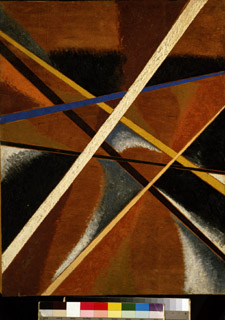In the ferment of post-Revolutionary Russia, the avant-garde was as militant as its name suggested – a true advance guard, sweeping aside every preconception that lay in its path. Death to the aristocracy, death to the bourgeoisie, death to capitalism. For each of those brusque sentences, there was to be a correlative in art and aesthetics. Away with hierarchies of taste, away with beautifully crafted works of art, serpent symbols of wealth and status. Away with the old romantic shibboleth that great paintings are holy relics, invested with the aura of individual genius.
Nothing was sacred to those who sought to express the collectivist ideals of Communism’s new world order. The painter, photographer and designer Aleksandr Rodchenko looked forward to a day when art and the State itself would have metamorphosed into one and the same thing. “Non-objective painting is the street itself, the squares, the towns and the whole world. The art of the future will not be the cosy decoration of family homes. It will be just as indispensable as 48-storey skyscrapers, mighty bridges, wireless, aeronautics and submarines, which will be transformed into art.”
Rigorously curated by the Russian art historian Margarita Tupitsyn, “Rodchenko and Popova: Defining Constructivism”, at Tate Modern, revisits the dawn of Russian Revolutionary art. Its subject is the Russian Constructivist movement, and the debates and arguments that attended its birth. The show concentrates on the contributions of two pivotal figures, namely Rodchenko himself – whose work as a photographer was explored in an exhibition of exactly a year ago at the Hayward Gallery – and his comrade in art, Liubov Popova. Over two hundred exhibits include paintings, drawings and constructions, as well as designs for posters, advertisements, textiles, stage sets and a host of objects of ordinary daily use. Yet so tight is the...


